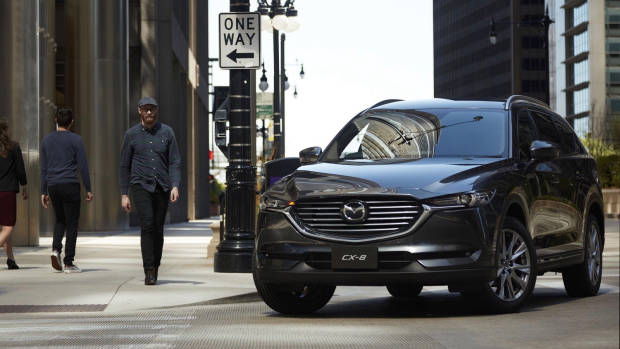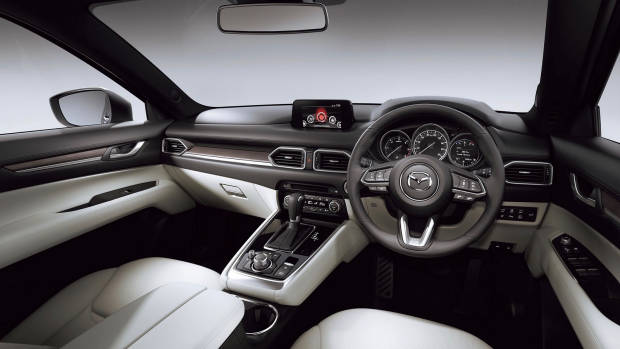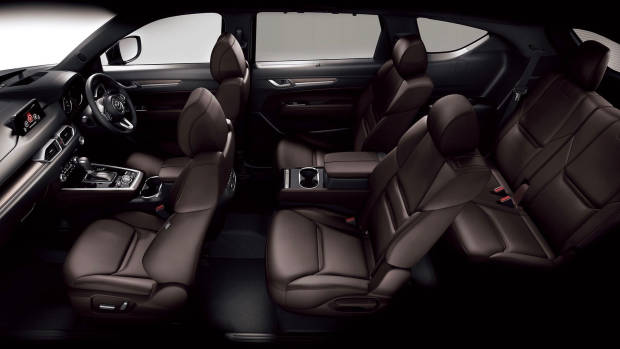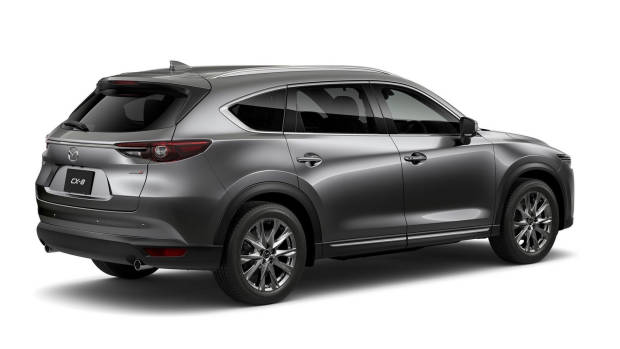-
Car Reviews
- Car News
-
Car Comparisons
Latest comparisons
- Chasing Deals
After a series of teasers, the six- or seven-seat Mazda CX-8 has finally revealed in Japan before a possible 2018 Australian debut. Fitting perfectly between the five-seat CX-5 and seven-seat CX-9, the CX-8 will be available in both six- and seven-seat layouts.
Sitting below the CX-9 globally, the CX-8 will become Mazda’s largest model in Japan, where the CX-9 has never been sold due to its size. Initially just for sale in Japan, the CX-8 will be sold only with a diesel engine, though if sold in more than just Japan, petrol units from the CX-5 will likely be made available as well.

Essentially straddling the halfway point between the CX-5 and CX-9, the CX-8 borrows from both cars heavily – the front appears to be more of the CX-5 with an almost identical front end and dashboard, yet the rear half of the car with its seat layout and rear end styling borrows from the CX-9.
In terms of powerplants, only one engine is available in Japan, an uprated version of the 2.2-litre turbo diesel used in the CX-5 and Mazda 6. In the CX-8, it produces 140kW of power and 450Nm of torque – 11kW and 30Nm more than the CX-5. It’s matched only to a six-speed automatic, and in Japan both front- and all-wheel drive drivetrains are available. Fuel economy is quoted as low as 5.7L/100km for front-wheel drive variants.

Dimensionally, the CX-8 fits right between the CX-5 and CX-9. Its 2,930mm wheelbase is identical to the CX-9, yet its width is 175mm shorter at 4,900mm. Its 1,840mm width is 129mm narrower, and its overall height of 1,730mm is just 17mm lower. With these dimensions in mind, the CX-8 certainly sits closer to the Santa Fe and Kodiaq as a ‘5+2’ seater, with the third row of seating more reserved for kids or occasional trips. Mazda claims that anybody under 170cm of height will be very comfortable in the third row, but those taller are out of luck.
With all three rows in use, the bootspace is listed as 230-litres – curiously, that’s nine litres larger than the CX-9 – whereas with the third row folded, cargo volume increases to 572-litres, which is much less than the CX-9’s 810-litres, but more than the much larger Toyota Kluger’s 529-litres. Whereas the CX-9 is available only with seven seats, the CX-8 is available with two seat configurations – a traditional seven-seat variant, or for families without a need for all seats to be in use, a six-seat variant with an optional middle-row console with covered storage and cupholders. Don’t get your hopes up for the six-seat variant however – if sold here, the six-seat variant’s low sales are likely to count it out for Australian consumption.

While if sold in Australia, we’d bet that Mazda’s 2.5-litre non-turbo petrol engine would also be made available, the CX-8’s appeal is that unlike the CX-9, it is available with a diesel engine. Whilst the CX-9 and rivals such as the Toyota Kluger and Nissan Pathfinder are petrol-only, other rivals such as the Hyundai Santa Fe, Skoda Kodiaq and Kia Sorento are available with diesel engine.
In Australia, diesel power makes up a large percentage of SUV sales, and because of this, Mazda Australia are reportedly keen to enter the diesel market and capture lost sales from the petrol-only and more expensive CX-9.

Mazda Australia have confirmed to local media that they have been offered an ADR-compliant version of the CX-8, and are still working on the car’s local business case before confirming any details. If sold here, we’d expect pricing to start at around $40,000 – below the CX-9, which had a recent price hike, but above a similarly-equipped CX-5. If Mazda Australia decides to sell the CX-8, expect a first half of 2018 local arrival.

Stay tuned to Chasing Cars for news regarding the Mazda range. Watch our CX-9 review here.
Latest news
About Chasing cars
Chasing Cars reviews are 100% independent.
Because we are powered by Budget Direct Insurance, we don’t receive advertising or sales revenue from car manufacturers.
We’re truly independent – giving you Australia’s best car reviews.